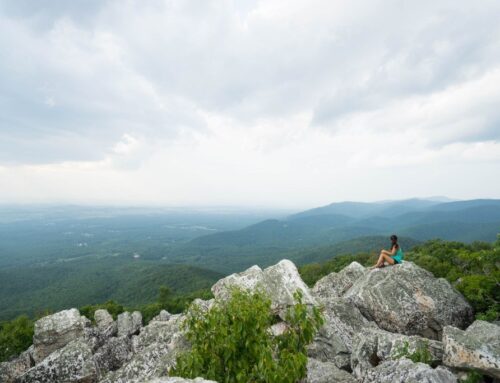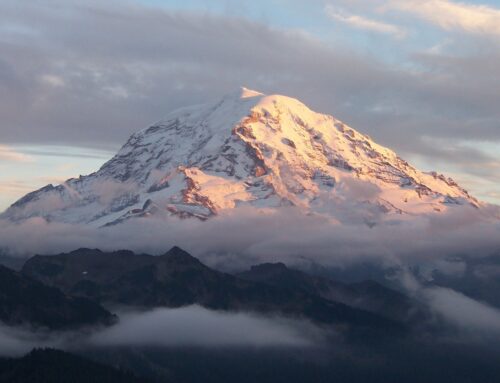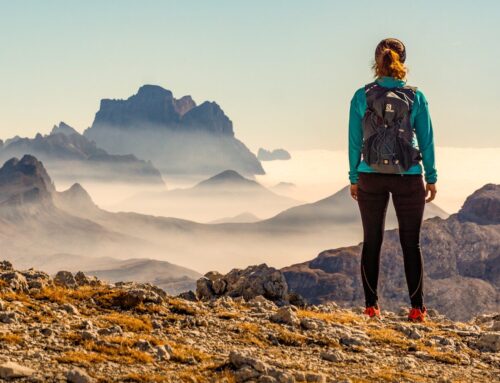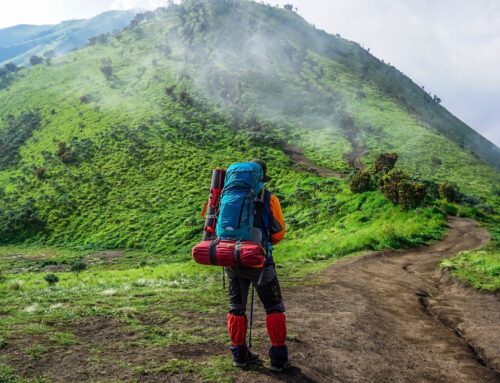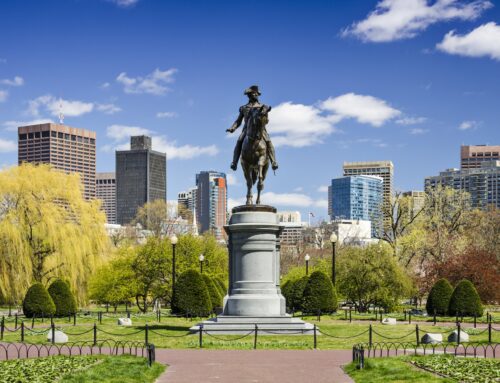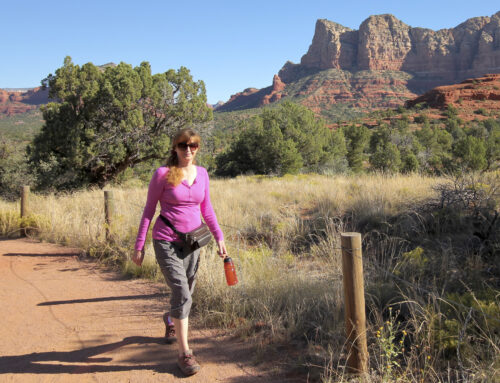Updated October 17, 2021
Hiking in Banff National Park is an adventure traveler’s dream. With its otherworldly pastel-colored glacial lakes, its evergreen forests, its incredible wildlife and, of course, its beautiful location in the Canadian Rockies, it’s no wonder the hikes in Banff National Park are some of the most famous in the world!
In fact, tourism has skyrocketed in Banff over the past few years, and it’s primarily because of the jaw-dropping viewpoints and awe-inspiring landscapes.
One of the best ways to experience and immerse yourself in the wild beauty of this national park is to hit the hiking trails in Banff.
But if you’re new to hiking, don’t worry! There are several places to go hiking in Banff for hikers of many different abilities and fitness levels.
To help you plan your trip to Banff, we’ve compiled a list of the most beautiful hikes in and around Banff National Park, including easy, moderate, and challenging trails. If you’re looking for some of the best trails to go hiking in Banff National Park, this list might give you some ideas to start with.

Easy Hikes in Banff National Park For All Levels
Johnston Canyon Trail
- Distance: 2.7 to 5.8 kilometers (1.6 to 3.5 miles)
- Type of trail: Out-and-back
- Estimated time: 2-4 hours
- Highlights: Tons of waterfalls and the strangely awesome Ink Pots at the end
Johnston Canyon is one of the most popular hikes in Banff, and it’s easy to see why. Waterfalls meet narrow stone gorges with a raging turquoise river in this beautiful and easy cliffside trail, which is perfect for solo hikers, couples and families of all hiking levels.
This Banff hike is unique because it consists of a series of cliffside metal bridges that take you through this stunning canyon…no uphills necessary!
There are a few different options for this hike, including a short version that takes hikers right up to the Lower Falls (the first set of falls), or the longer version that extends all the way through the Upper Falls to the “Ink Pots,” a colorful phenomenon that occurs in these natural pools in Banff National Park.
If you want to avoid the crowds (and yes, this trail does get crowded), be sure to get started hiking early in the morning.
How to get there: Upon parking in the designated Johnston Canyon parking lot, you’ll follow signs and head past the shop/cafe towards the entrance, where you can start the trail.

Moraine Lake Trail
- Distance: ~0.8 km (0.5 miles)
- Type of trail: Loop
- Estimated time: 30-45 minutes
- Highlights: The famed view of Moraine Lake that you’ve probably seen a million times on Instagram
If you’ve been on Instagram in, ya know, the last 2 seconds, you’ve probably seen a staggeringly beautiful photo of some beautiful rocky peaks atop a glistening turquoise alpine lake. This view, overlooking Moraine Lake, is one of the most iconic sights of Banff National Park.
Needless to say, the Moraine Lake “rockpile” is not only an Instagram-famous spot, but it’s also one of the best short hikes in Banff National Park.
Located near the famed Lake Louise, Moraine Lake has several areas to hike, and it is a stunning easy day trip if you’re crunched for time. You can pair this hike with a trip up to Lake Louise – and either the Lake Agnes or Plain of Six Glaciers hikes – or with a side jaunt to Johnston Canyon.
To avoid heavy crowds and traffic, go VERY early in the morning in the late spring and summer (I mean, like 5 AM early).
How to get there: Before arriving at Lake Louise, you’ll turn off of the main road following signs to Moraine Lake. Park in the parking lot and you can begin hiking to the rockpile.
For more on hiking at Moraine Lake, read this Moraine Lake Viewpoint Guide.
Note: Due to habitat protection, this area is subject to closures. Be sure to check here for updated info.

Hoodoos Hiking Trail
- Distance: 3 to 4.6 km
- Type of trail: Out-and-back
- Estimated time: 1.5 to 3 hours
- Highlights: Views of the Bow Valley below and the strange hoodoo rock formations
Some of the most unique rock formations in the park are known in Banff as the hoodoos, or fairy chimneys. Famous in places like Cappadocia or the American Southwest, the hoodoos are rocks that look like spears sticking out of the earth.
The Hoodoos Trail gives hikers a unique viewpoint with which to admire these magical natural phenomena. It’s one of the more popular Banff hiking trails since it’s so close to Banff town.
But I’ll be honest for a minute: the Hoodoos are not the highlight of this hike.
Actually, we’ve included this easy hike on our list because of its spectacular views of Bow Valley. It’s close to the Surprise Corner, one of the most beautiful viewpoints in the park, and boasts stunning bird’s eye views on clear days.
So, yeah, go see the Hoodoos (you might think they’re awesome or totally underwhelming), but don’t forget to open your eyes for the real treat: the Rocky Mountain views, the Bow River, and its surrounding evergreen forests.
For more on hiking to see the Hoodoos, be sure to check out the Hoodoos Trail Guide.
Note: This trail is subject to closures, so check here for the latest updates.
Two Jack Lake
- Distance: 3.2 km (2.0 miles)
- Type of trail: Loop
- Estimated time: 30 minutes to 1 hour
- Highlights: One of the most beautiful (and underrated) photo spots in all of Banff
The glistening Two Jack Lake is a peaceful respite located just off the main Trans-Canada Highway, with hiking trails all around its perimeter. With the gorgeous Mount Rundle in the background, and several other rocky peaks in the distance, this glassy lake provides an incredible and easy morning hike/stroll, especially if you are planning on camping in the Two Jack Lakeside campground.
In the early morning, fog covers the crystalline water, and on clear days you can witness the near-perfect reflection of the evergreen trees and Mount Rundle. Or, if you’re camping in the campsite, you might be able to catch some epic stargazing along the lakeside. If you’re at Banff in the fall or winter, you can sometimes catch the aurora borealis glistening above the trees on clear nights!
For more on hiking/camping in Two Jack Lake, read this Two Jack Lake Guide.

Lake Agnes
- Distance: 7.4 km (4.6 miles)
- Type of trail: Out-and-back
- Estimated time: 2-3 hours
- Highlights: Beautiful little alpine lake and a teahouse with a view!
Want to treat yourself to tea and cookies on a fairly easy hike to a secluded glacier lake?
The Lake Agnes trail, situated next to Lake Louise, might be the perfect short hike for you. With amazing views of the teal Lake Louise, and a fairly gradual uphill climb, this hike is perfect for hikers of all levels. This is one of the more popular hikes in Banff, so head there early in the high season.
And, surprise, it ends at an alpine tea house! The Lake Agnes tea house is cash only (CAD and USD accepted), so make sure you have some change with you if you want to buy a snack or drink. We strongly recommend bringing CAD as USD is exchanged at a rate of 1:1 up there.
How to get there: Park in the Lake Louise parking lot, pass through the front of the Chateau Lake Louise, then walk around the right side of the lake (when facing away from the hotel) to the trail head near the edge of the forest. In the summer, the parking lot usually fills VERY early, so come early.
For more on hiking the Lake Agnes trail, read the official Lake Agnes Guide.
Note: This area is subject to closures, so be sure to check here before you go.

Moderate Hikes in Banff
Cascade Amphitheatre
- Distance: 13.8 km (8.6 miles)
- Type of trail: Out-and-back
- Estimated time: 3.5 to 6 hours
- Highlights: Amazing views of the rockies!
In the winter, the Cascade Amphitheatre area is full of skiers and resort goers. However, in the summer, the entire park of the park turns into a hiking zone, with incredible views and proximity to some pretty cool rock formations.
The Cascade Amphitheatre hike is one of our favorite hikes in Banff because of its stunning views and challenging (but not too strenuous) trails.
Cutting through a valley with rocky mountaintop views, forested trails, and bubbling streams, this hike is a tranquil adventure into the woods. The Amphitheatre itself is a green valley surrounded by almost 360-degree views of the surrounding mountains. It really does look like a naturally-formed amphitheatre, showcasing some of the most stunning views of the surrounding Canadian Rockies.
How to get there: Follow signs on the Trans-Canada highway for Mt Norquay Skit Resort. Park in the parking lot and the trailhead can be found nearby.
Note: Check the park webpage for information on closures before you go.
Chephren Lake Hiking Trail
- Distance: 8 km (5 miles)
- Type of trail: Out-and-back
- Estimated time: 3 to 5 hours
- Highlights: Arguably one of the most picturesque lake hikes in Banff
If you’re looking for a tranquil hike that’s outside of the main tourist drags in the park, head to Chephren Lake. This lesser-known hike off the Icefields Parkway in Banff boasts beautiful forests and winding trails. Hikers that make it to the end are rewarded with an incredible mountain view amidst a quiet, teal blue alpine lake.
In our opinion, this is one of the best hikes in Banff for photographers, as the gorgeous lakes with stark mountain backdrops are really interesting.
While Chephren Lake isn’t necessarily a difficult hike, the trail can be a bit unkempt and difficult to maneuver. You can either do this hike by itself or pair it with a hike to the nearby Cirque Lake for a long, full day hike to two stunning lakes.
How to get there: Follow signs on the Trans Canada highway for Waterfowl Lakes Campground. Turn into the dead end within the campsite and you’ll find the trailhead for Chephren Lake.
For more on hiking Chephren Lake, read the Chephren Lake Guide.
Note: This area is subject to closures, to check here for the latest updates before you go.
Plain of Six Glaciers
- Distance: 14.6 km (9.1 miles)
- Type of trail: Out-and-back
- Estimated time: 4 to 6 hours
- Highlights: Plain of Six Glaciers tea house, Abbots Pass views
As one of the most popular trails for hiking in Banff National Park, the longer, more difficult (and arguably more beautiful) sister of the Lake Agnes hike is the Plain of Six Glaciers trail.
Rocky, winding dirt trails take hikers from the crowded shores of Lake Louise into secluded getaways deep in the Rocky Mountains. In our opinion, this is one of the most spectacular hiking trails in Banff National Park, and we’d recommend doing this one if you’ve got limited time in the park.
Visitors can expect to see beautiful, towering glaciers, craggy mountain peaks, and scenic passes through the wilderness. In the summer, hikers can stop for a quick rest at the Plain of Six Glaciers tea house, where they serve hot beverages and snacks for passers-by.
But before descending back down the way you came, be sure to stop by Abbots Pass for some of the most jaw-dropping views in the park.
How to get there: Park in the Lake Louise parking lot, pass the Chateau Lake Louise, and take the trail head that begins to the right of the lake at the edge of the forest. Once you are there, you will see signs to the Plain of Six Glaciers hike (it’s the same one as the Lake Agnes Trail).
For more on hiking the Plain of Six Glaciers trail, head over to this Plain of Six Glaciers Guide.
Note: This area may have some closures, so check here before you go.
Bourgeau Lake and Harvey Pass
- Distance: 20.4 kilometers (12.5 miles)
- Type of trail: Out-and-back
- Estimated time: 6.5 to 9 hours
- Highlights: A must-do hike in Banff – there’s a little bit of everything with some spectacular views on top!
One of the most incredible day hikes in Banff National Park, Bourgeau Lake and Harvey Pass is a challenging but memorable hike to tackle. This full-day hike brings you to some of the best landscapes in the park, including many peaceful, secluded lakes, and panoramic views of the park.
Although this is the longest “moderate” hike on our list, it’s well worth the effort for a full day of adventuring through alpine trails and forests.
Throughout the hike, you might see some wildlife, including little chubby marmots (that we thought were adorable!). You’ll pass through Bourgeau Lake and Harvey Lake, both perfect places for a snack or a break. You also have the option of summiting Mount Bourgeau, although it is definitely a difficult scramble!
How to get there: Park in the lot for Bourgeau Lake (follow signs from the Trans-Canada Highway), then follow signs to the trail head.
For more on hiking Harvey Pass, read this Bourgeau Lake and Harvey Pass Guide.
Note: For updates on closures in this area, visit the park webpage.

Healy Pass
- Distance: 18.3 km (11.4 miles)
- Type of trail: Out and back
- Estimated time: 5 to 7 hours
- Highlights: Really spectacular views of pretty much everything.
The Healy Pass trail has a little bit of everything – quiet forests, rolling alpine pastures, cold creeks, and more. But perhaps the most worthwhile thing about Healy Pass is its breathtaking views of the mountains and valleys, as well as Egypt Lake nearby. Bring your camera, because these are some of the most amazing panoramas in the park (and maybe even in the world).
Although it’s long, this hike is fairly moderate, with a very gradual incline that’s accessible to most hikers. You’ll hike mostly through trees in the beginning, but once you pass through the tree line up into the rocky peak area, you’ll be dazzled with amazing views of all of the mountain’s surroundings.
How to get there: Follow signs to Sunshine Village from the Trans Canada Highway. There’s a marked pathway near the building that you’ll follow to begin the hike.
Note: This park is subject to closures so check here before you go.
Difficult Hikes in Banff
Helen Lake and Cirque Peak Trail
- Distance: 14.5 kilometers
- Type of trail: Out-and-back
- Estimated time: Full day (up to 9 hours)
- Highlights: Some of the best mountain views EVER.
The Helen Lake and Cirque Peak hike is a difficult one, but worth it for stunning views of the glistening lakes and emerald valleys tucked beneath snowy, gray mountaintops. This is one of the least technical peaks, making it one of the most accessible – but challenging – summit hikes in Banff National Park.
Towards the top of Cirque Peak, this hike involves some rock scrambling, but doesn’t require any advanced technical skills or knowledge. Breathtaking views from the summit boast panoramic access to the valleys below. And congrats – you’ve just summitted a mountain!
How to get there: Park in the Helen Lake parking lot and follow signs to the trailhead for Helen Lake.
For more on hiking Helen Lake and Cirque Peak, you can read this Helen Lake and Cirque Peak Guide.
Note: Visit here for the latest updates on park closures.

Aylmer Lookout via Lake Minnewanka
- Distance: Total 26 km (but can be broken down into a shorter hike!)
- Type of trail: Out-and-back
- Estimated time: Full day (up to 9+ hours)
- Highlights: Yup, you guessed it: incredible, incredible views of basically the entire Banff National Park
With stunning views of nearby mountains, steep valleys, and the popular Lake Minnewanka below, the Aylmer Lookout hike is one of the best viewpoints in Banff National Park.
Although the trail is nearly 26 km, hikers can see incredible views much earlier in the hike, making the trail as long (or as short) as they’d like. Starting from the shores of Lake Minnewanka and climbing up into the mountains above, this trail has a variety of terrain and difficulty that’s suitable for hikers of all levels.
How to get there: Park in the Lake Minnewanka parking lot, then begin the lakeside loop trail to the trailhead for Aylmer Lookout.
Note: This area is subject to wildlife and COVID closures, so be sure to check the status before visiting. Additionally, bikes and dogs are not allowed on this trail, and hikers must be in a group of at least four and carrying bear spray.
Cascade Mountain Trail
- Distance: 19.8 km (12.5 miles)
- Type of trail: Out-and-back
- Estimated time: 7-10 hours
- Highlights: Rock scrambling, breathtaking summit views
Another mountain summit, the Cascade Mountain summit hike is a challenging yet rewarding experience with spectacular views. It requires some scrambling near the top of the trail, and there’s a false summit or two, but the trail boasts amazing views of the nearby mountains and the entire park. Plus, you can say you hiked to the summit of a mountain in Banff, which is pretty freaking cool.
Cascade Mountain is a continuation of the Cascade Amphitheatre hike, so if you’re up for a longer day hike from there, this one is a wonderful hike to take on. It’s a challenging but accessible summit hike that’s a real treat for hikers up for an adventure.
How to get there: Park in the Mt Norquay parking lot and begin the trail to Cascade Amphitheatre.
For more on hiking Cascade Mountain, read this awesome Cascade Mountain Guide.
Note: This area is subject to closures, so check here before you go.

Mount Rundle Trail
- Distance: 15.1 km (9.4 miles)
- Type of trail: Out-and-back
- Estimated time: 7-9 hours
- Highlights: One of the most challenging and amazing summit hikes in Banff! (And, of course, the bragging rights…)
Some say that Mount Rundle boasts the cream of the crop views down into the Banff Valley. We believe it. This 13.7 km difficult hike climbs up a steep trail on the mountainside, finally reaching a rocky ridge that leads to the panoramic summit.
Hikers who have finished this hike have said that it’s very challenging, but with enough willpower and stamina, the breathtaking views are truly worth it. Known as one of the most difficult hikes in Banff National Park, completing this trail is a huge feat.
For more on hiking Mount Rundle, read the Mount Rundle Guide.
Note: Check the park website for the latest updates on closures.
Hiking in Banff National Park: The Basics

Things You Need to Know Before Hiking in Banff
With its increasingly famous landscapes, Banff is becoming more and more popular with tourists each year. It’s a perfect place to go as a beginner hiker looking for an outdoor adventure, or as a seasoned hiker looking to bag a few summits in a short time. Either way, Banff is still an alpine national park that experiences extreme conditions and comes with risks.
To prepare you for what to expect while hiking in Banff, here are a few tips:
- You can hike year-round in Banff! While the warmest season of the year in Banff is summer, Banff actually has trails open all year! In our opinion, the best time to hike in Banff is in the spring or the fall, when the weather is warm enough to stay outside for extended periods of time but the summer crowds have subsided. Most of the tourists flock to Banff in July and August, so if you want to avoid massive tourist crowds, avoid those months. If you’re hiking in the winter, you’ll need to take special precautions and wear crampons.
- Trails can still be snowy and icy all year, even in the summer. When we visited Banff in late May, there were still a bunch of trails that were closed due to icy conditions. Sometimes, trails can even get icy or snowy in the summer. Be sure to stay updated on the trail conditions before going hiking in Banff. To check trail warnings and closings, visit the Parks Canada website.
- There’s TONS of wildlife in Banff year-round. Bears, mountain goats, elk, wolves… There are these species and more all over Banff, so it’s important to know what to do in the event of a run-in with them. Always bring bear spray, avoid hiking alone, and look for notices on the trail heads about recent wildlife sightings.
- Banff isn’t that remote. There’s a nice, posh little town in the middle of the park that has basically everything you could ever need. Many areas of the park also have cell phone service. However, it is in the mountains and you’ll want to make sure all the important information you need is stored somewhere offline.
What to Pack for Your Hikes in Banff
Hiking in Banff National Park is pretty similar to hiking in other alpine national parks. You might experience 4 seasons in a single day, or spot a bear in your tracks. It’s important to bring all of the necessary gear that will help you out in these potentially extreme situations.
Weather conditions can change rapidly in these alpine paths, so we recommend bringing lots of layers – including a thermal later and a waterproof shell – with you on every hike. You’ll also want ample water and snacks, as many of the trails are long and some are quite far from Banff town, where the majority of cafes are.
Here are a few necessary items for hiking in Banff. Don’t travel without them:
Clothing for Banff
- Travel insurance – You don’t want to go hiking in Banff without travel insurance, especially if you’re not from Canada! We use and recommend World Nomads – they’ve saved us in life-threatening medical emergencies, evacuations from mountain passes in Patagonia, and more. If you want to learn why travel insurance is a necessary part of every trip, read our guide to travel insurance.
- Waterproof hiking boots – While hiking in Banff, there’s a good chance you’ll be caught walking in mud, snow, and stream crossings. To keep my feet warm and dry during day hikes, I have a cozy pair of Ahnu waterproof hiking boots (men’s version here) that always do the trick! My boots have been with me to Patagonia, Peru, Slovenia, and more, and they’re still kicking (haha, get it?!).
- Merino wool layers – It’s a really good idea to bring a merino wool baselayer (men’s version here), which will keep you cool in the summer and warm in colder weather. Merino is soft, sturdy, stink-free, and sweat-wicking, AKA the best fabric ever for hikers. We use Smartwool baselayers and love them.
- A waterproof rain shell – No matter what time of year it is, there’s a decent chance of sudden rain in the Canadian Rockies, even if the skies are blue. Bring a sturdy, waterproof rain jacket (men’s version here) to stay warm and dry while hiking in Banff.
- A compressible down jacket – Temperatures in Banff can be chilly even in the summer, especially as you gain altitude in your hikes. For this reason, I always make sure to pack my thermal puffer, all rolled up into a tiny ball that I can shove into the bottom of my day pack.
- Mosquito repellent, sunscreen, and sunglasses – Duh.
Hiking Gear for Banff
- Trekking poles – For the more strenuous hikes, you may want to take a sturdy pair of retractable trekking poles with you for easier leverage on rocky slopes. They’re great for sharp downhills or for keeping your balance on rocky trails. (Or, for using as a “cane” after particularly long hikes…yeah, that’s a thing.)
- Head lamp -Sometimes the best views are at sunset or sunrise, and you’ll end up needing to hike when it’s a bit dark outside. I love my trusty head lamp for hiking in the early morning or late evening.
- Hammock – Totally optional, but trees are abundant in Banff and you may just want to take a little nap with a view… a packable 2-person hammock can help with that.
- Reusable water bottle and filter – Reminder: you’re in a national park and it’s super important to minimize your plastic consumption. However, clean water is a must, so we always bring water purifiers and a reusable water bottle. I love pairing my rock-solid Hydro Flask with my SteriPen Aqua and Sawyer Products Mini Water Filter for clean, cold water on the go.
- Bear spray – You probably won’t have to use it, but this will help you out in the event of a bear sighting. You can get bear spray at any outdoor retailer in Canada, just make sure to leave them behind before you fly on a plane!
Getting To & Around Banff National Park
Unless you live in Alberta or British Columbia, you’ll most likely fly into Calgary International Airport (YYC).
Once you arrive, the best way to get around the Canadian Rockies is by renting a car. At Calgary’s airport, there are tons of car rental agencies you can rent from – I rented from Avis every single time I visited Banff (over 12 times!) and the process was always seamless and easy. I’d recommend them if you’re looking for a car rental at YYC Airport.
You can also rent a car in downtown Calgary or in nearby Edmonton, at the airport or downtown.
From Calgary, you will take the Trans-Canada Highway AB-1 going West. The trip takes just over an hour to get to the front entrance of the park. There are a few buses that go to and from the Banff town center, but for people who want to go hiking in Banff, there’s really no other way to get to the various campsites, landmarks, and hiking trails in Banff National Park.

Where to Stay In & Around Banff National Park
Let me put it to you this way: good accommodation in Banff (including campsites) sells out QUICKLY. This means you should probably look into booking your hotel, hostel, or campsite ASAP.
If you’re thinking about visiting Banff but aren’t sure yet, I’d recommend comparing hotels in Banff on HotelsCombined, which aggregates all of the different prices from the Internet into one easy platform, or booking a cancellable place on Booking.com.
Here are a few of the best and most beloved options for where to stay in Banff:
- Luxury Lodges: If you’re hoping to make your Banff vacation a splurge, you can’t go anywhere else than the Fairmont Chateau Lake Louise. Honestly, it’s worth just ogling the photos online. With stunning views of the lake, access to several hiking trails from hotel’s the back door, and fine dining available, what could be more luxurious or convenient?
- Mid-Range Hotels: For travelers who want a good level of comfort but don’t want to spend an arm and a leg, there are several inns, hotels, and lodges available in Banff town and on its outskirts where visitors can stay. Again, these book up very early for the summer months, so be sure to reserve far in advance. Mid-range travelers love the Rundlestone Lodge and the Banff Park Lodge, with wonderful service and fabulous locations (with mountain views, of course!!).
- Budget Hostels: If you’re on a budget but don’t want to camp, there are a few hostels available in the Banff area that are perfect for travelers on a shoestring. I haven’t personally stayed in any hostels in Banff, but Banff International Hostel is the most popular option for backpackers in the area. For the more hardcore hikers, HI Lake Louise Alpine Centre and HI Banff Alpine Centre are awesome alpine options.
- Camping: There are several front- and back-country campsites available in Banff and the surrounding areas. The cheapest and least crowded of these are in Canmore, which is in between Calgary and Banff.If you’re planning on visiting Banff during the summer, your best bet is to reserve your campsites ahead of time on the Parks Canada website.
Check reviews and compare prices for hotels & hostels in Banff
Related Links
- The Ultimate Day Hiking Packing List
- What to Wear Hiking: Best All Season Hiking Clothes for Women & Men
- Best Trekking Poles to Help You Tackle the Toughest Trails (2021)
- 12 Incredible Hikes in Canmore & Kananaskis for All Levels
- 15 Wonderful Places to Go Skiing Near Calgary
Did you enjoy this post? Pin it for later!
Planning a trip to Banff? Want to learn more? Come join the conversation in the Jetfarer Facebook group!

